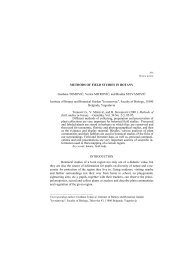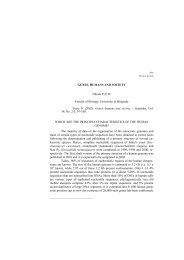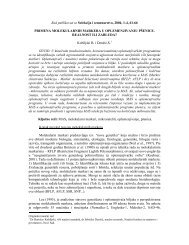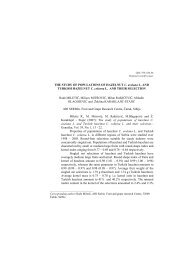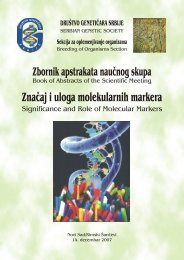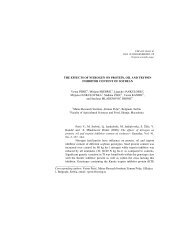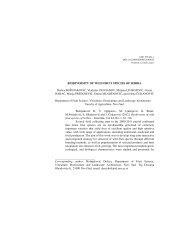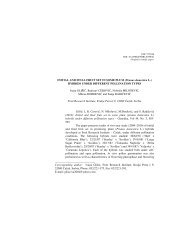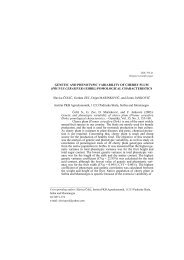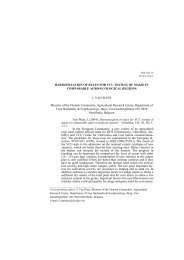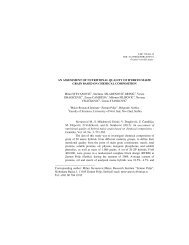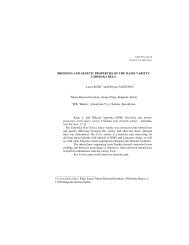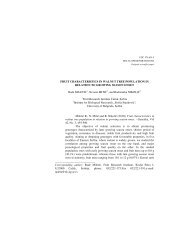Zbornik - Društvo genetičara Srbije
Zbornik - Društvo genetičara Srbije
Zbornik - Društvo genetičara Srbije
You also want an ePaper? Increase the reach of your titles
YUMPU automatically turns print PDFs into web optimized ePapers that Google loves.
84 ZBORNIK ABSTRAKATA III KONGRESA GENETIÈARA SRBIJE IV-Uvo-1<br />
Subotica, 30. novembar - 4. decembar 2004.<br />
MOGUÆNOST GENETIÈKE KONTROLE OTPORNOSTI PREMA<br />
VOLOVODU (Orobanche cumana L.) NA SUNCOKRETU KOD NAS I U SVETU<br />
D. Škoriæ i S. Jociæ<br />
Nauèni institut za ratarstvo i povrtarstvo, Novi Sad<br />
Suncokret napada volovod (Orobanche cumana L). Glavni centri napada volovoda na<br />
suncokretu su zemlje oko Crnog Mora (Rusija, Ukrajina, Moldavija, Rumunija,<br />
Bugarska i Turska). Drugi centar gde volovod napada suncokret i nanosi znaèajne<br />
ekonomske štete je Španija, a treæi Izrael. U predhodne dve godine volovod je pronaðen<br />
na suncokretu i u zapadnom delu Kine. Volovod je prenet u našu zemlju najverovatnije iz<br />
Bugarske ili Rumunije, gde je Orobanche cumana L. znatno ranije bio prisutan.<br />
Orobanche cumana L. je stranooplodna parazitna cvetnica i pojava novih rasa je stalno<br />
prisutna.<br />
Izvori otpornosti prema volovodu se nalaze u više divljih vrsta suncokreta, ali je najveæa<br />
frekvencija gena za otpornost prema volovodu prisutna u H. tuberosus.<br />
U Evropi je dugo bila prisutna samo jedna rasa volovoda (rasa A) koju kontroliše jedan<br />
dominantni gen Or1. Polovinom 20-og veka naglo se proširila rasa B. Otpornost kod<br />
suncokreta prema rasi B kontroliše jedan dominantni gen (Or2). U drugoj polovini 20.-og<br />
veka došlo je do pojave novih rasa C (Or3), D (Or4) i rase E(Or5). Dugo godina u našoj zemlji je bila dominantno prisutna rasa B prema kojoj su otporne<br />
ruske sorte i novosadski hibridi. Pred kraj 20-og veka kod nas se takoðe proširila rasa E<br />
(Baèka i Banat). Prema rasi E su otporni hibridi Baèvanin i Perun i velik broj novih inbred<br />
linija.<br />
POSSIBILITIES FOR GENETIC CONTROL OF SUNFLOWER<br />
RESISTANCE TO BROOMRAPE (Orobanche cumana L.) AT DOMESTIC<br />
AND INTERNATIONAL LEVELS<br />
The sunflower is attacked by broomrape (Orobanche cumana L). The main centers of<br />
broomrape attacks against sunflower are Black Sea countries such as Russia, the Ukraine,<br />
Moldova, Romania, Bulgaria and Turkey. The second major region where broomrape attacks<br />
this crop species and causes significant economic damage is Spain, while the third<br />
is Israel. Over the last two years, broomrape infestations of sunflower have been reported<br />
in western China as well. Broomrape was most probably introduced to Serbia and<br />
Montenegro from Bulgaria or Romania, where it had been present for quite some time<br />
before that.<br />
Orobanche cumana L. is an open pollinated floriferous parasite and new races of it appear<br />
all the time.<br />
Sources of resistance to broomrape can be found in several wild sunflower species, but<br />
the greatest frequency of these genes is found in H. tuberosus.<br />
For a long time, Europe had only one broomrape race (A), resistance to which is controlled<br />
by a single dominant gene called Or1. In the mid 20th century, however, a new<br />
race (B) appeared and spread rapidly. Sunflower resistance to race B is controlled by the<br />
dominant gene Or2. In the latter part of the 20th century, several more races of this parasite<br />
appeared, namely races C (Or3), D (Or4) and E (Or5). For many years, Serbia and Montenegro was dominated by broomrape race B. Resistance<br />
to this race is present in Russian cultivars and Novi Sad hybrids. At the close of the 20th<br />
century, race E also appeared in the country and spread across the regions of Baèka and<br />
Banat. Resistance to race E exists in the hybrids Baèvanin and Perun and a large number<br />
of new inbred lines.



